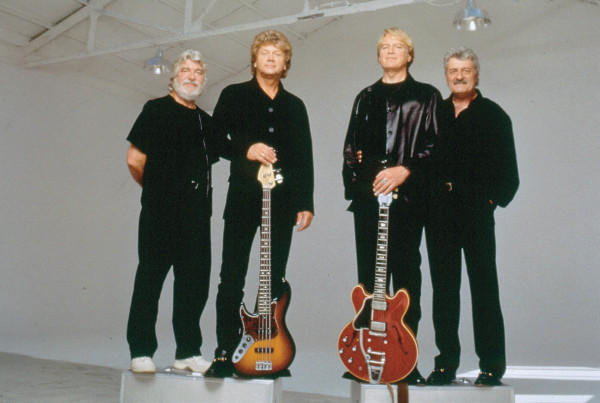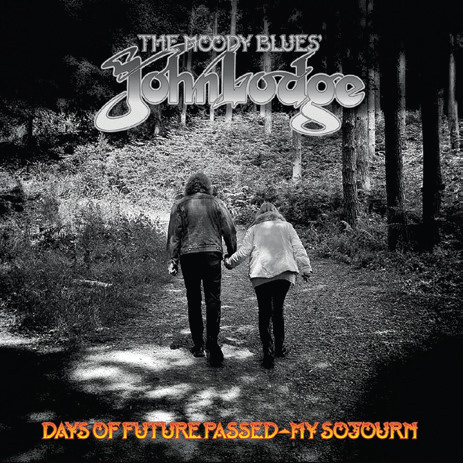Does anyone know what became of the missing 5.1 surround mix on the SACD of In Search Of The Lost Cord? It's listed in the accompanying booklet as having been remastered from the original Quad mix.
Moody Blues: Passed, Present, And Future

What was a poor working-class band to do?
Personnel issues, financial straits, and other typical growing pains had resulted in Laine (who recently passed away at age 79) and bassist Clint Warwick departing the fold in 1966, paving the way for guitarist/vocalist Justin Hayward and bassist/vocalist John Lodge to enter the Moodies picture alongside co-founding members keyboardist/vocalist Mike Pinder, drummer/spoken-word specialist Graeme Edge, and flutist/jack-of-all-trades Ray Thomas.
This staunch five-man outfit would put their collective careers on the line in order to create the cross-genre hybrid concept LP that became November 1967’s Days of Future Passed, a gutsy album that meshed the band’s core pop sensibilities with brave compositional choices. At the same time, Decca, the Moodies’ parent record company, was intent on putting out a demo record of sorts on the burgeoning Deram imprint that would champion their recently new stereo-centric audio format dubbed Decca Panoramic Sound — a.k.a. the Deramic Sound System (DSS) — by marrying The Moody Blues’ pop/rock sensibilities with classical music elements courtesy the London Festival Orchestra as conducted by arranger/composer Peter Knight.
While rock musicians recording with and playing alongside orchestras is essentially de rigueur these days — if not an expected rite of passage for many an artist at this point in the 21st century — it was literally unheard of in the heart of the swinging 1960s. But once Days of Future Passed made its way into the public consciousness with truly transcendent tracks like “Nights in White Satin” and “Tuesday Afternoon” leading the way, The Moody Blues never looked back. They capitalized on the tenets of the Deramic Sound conscription by taking a keen interest in forging exactly how their music would sound on vinyl — as well as on the then-emerging stereo-oriented component of the airwaves known as FM radio. To do so, they worked closely with producer Tony Clarke and recording engineer Derek Varnals to craft a signature sound that set a tone for how the mostly concurrent quad mixes for the majority of their studio albums released between 1967-72 — LPs known as “The Classic Seven” — would become early immersive audio templates. Unlike what happened with a few too many of their contemporaries’ quad releases of that era, the Moodies’ sound palette actually broadened in quad — and because of their multitrack/multichannel proclivities, their albums were ripe for eventual 5.1 upmixes near the turn of the century as well as a number of subsequent, all-new surround mixes and (we hope) eventual forays into the full-on Dolby Atmosverse at large.

DAYS OF IMMERSIVE FUTURES
It’s worth noting the linchpin track on Days of Future Passed, “Nights in White Satin,” really opened up the Moodies’ 360-degree hatch. On the 24-bit/96kHz DTS-HD Master Audio 5.1 DVD version of Days released by UMC/Deram in 2017, mixmasters Mark Powell and Paschal Byrne quite masterfully “manipulated” (in their words) the initial of-era 1972 quad mix done by original producer Clarke and original engineer Varnals into modern 5.1 royalty — and they also did it a full decade-plus following the album’s 2006 release on SACD. In 5.1 on the 2017 DVD, the breathtaking 80-second orchestral swell that follows lead vocalist Justin Hayward’s final, impassioned “Oh, how I love you” is followed quite pithily by the properly austere, back-channel-only “Late Lament” narration by Mellotron maestro/gong hitter Mike Pinder.
“Tony Clarke and Derek Varnals had done the original quad mix in the Decca studio,” recalls Hayward, “so they had exactly the same echoes and whatever else they were able to bring in, even though the desk had been updated. Decca never threw anything away, so they were able to bring in a whole section of the mixing desk — about 12 faders — to get exactly the same EQ and mix on it. For the 5.1 mixes I did with Alberto [Parodi] for our Timeless Flight box set, there’s nothing added on them except some ambience things in the surrounds.” (The Moody Blues’ hard-to-find 2013 11CD/6DVD Timeless Flight import box set on UMC offers said Days surround mix on the DVD designated as Disc 15.)

Hayward remains floored by what he heard of Days in surround. “I was just sitting there in the studio with Alberto working on the 5.1 and thinking, ‘How the hell did we do this? How the hell was it done?’ There’s a song on there called ‘Dawn Is a Feeling’ where Mike [Pinder] got all the Mellotron things just right. I can’t take any credit for it, because it really was Derek who did it — and I’m so glad he did the quad version back then in such beautiful quality since it saved me a lot of time and pain. It was a responsibility I don’t think I’d liked to have taken on myself.”
Over the course of the passed, er, past 30-plus years, I’ve had the privilege of speaking with all five of the Classic Seven-era Moodies — two of whom are sadly no longer with us — in addition to their aforementioned quad-leaning engineer. Days of Future Passed serves as a career-defining album of great aural poetry that will continue to be enjoyed by scores of fans both old and new alike, long after we’re all gone from this plane of existence.
For various reasons, the balance of the Moodies conversations that follow have neither been transcribed nor shared anywhere — until now, that is. Herewith, in their own words, The Moody Blues and their recording team relay the tales behind the impetus for and making of Days of Future Passed, one of popular music’s most important albums. Just what you want to be / You will be in the end. . .

PEAK-HOUR PERFORMERS
Derek Varnals (recording engineer, 1967-72): We recorded “Nights in White Satin” that first week of October 1967, and it was going to be the single. It wasn’t recorded with stereo in mind at all — it was done in mono, and it was done very much on our third-generation 4-track because we’d gone from one 4-track over to another 4-track and back again, just to create enough tracks to get all the layers on it that we wanted.
And then, within two weeks, the band were brought back to Decca to do an album. The idea was that we were going to make an LP of a song cycle that illustrated a day, and then we’d record another couple of numbers. We’d had a meeting at the head office just before we recorded the next track where it was decided we would use [conductor] Peter Knight because we’d done a similar project with him already, whereby we had layered orchestra onto a rhythm section for [1965’s] Western Heritage, an album that was inspired by the [1962] film How the West Was Won. It had all the typical cowboy songs that would appeal to America, and it was also kind of a continuous play — an episodic kind of thing. The idea of adding orchestra onto a rhythm track by overdubbing wasn’t unheard of, and I think that was what inspired the choice for us going with Peter Knight — apart from the fact he’s a really good arranger.
Anyway, “Nights in White Satin” was recorded as a mono single, and it came out [on November 10, 1967] about a month after we recorded it. There was this intervening period when [Decca A&R man] Michael Dacre-Barclay must have heard “Nights in White Satin” because Tony Clarke, the producer, had brought the acetate up to the head office and was playing it — and it was attracting some attention. I think Michael thought, “Oh, wow, this is a good idea. That sounds quite orchestral. We could grab the band and do both rock group and orchestra on this label together.” And then it all took off from there.
It just so happened the theme of Days of Future Passed dictated itself because they had a couple of songs already written, like “Dawn Is a Feeling.” According to my studio notes, we recorded “Nights in White Satin” on the 8th of October, and the next one we did was “Dawn Is a Feeling,” which was on the 18th of October. It was only ten days later, and we were embarking on the album! (laughs) The next track we did was “Peak Hour,” which was on the day we met at the head office to formulate it all. That’s when The Moody Blues, Tony Clarke, and myself went up to see [executive producer] Hugh Mendl and Mike Barclay and we said, “Look, we’ve got an album coming together now. There are three songs that cover night, dawn, and the peak hour, and Justin already has ‘Tuesday Afternoon’ planned, but it’s not finished. So, we’re going to record a day. That’s the theme of the album.” And then Michael said, “Well, that would work by having them linked together with an orchestra — and Peter Knight is the man for the job.”
We started the Days of Future Passed album proper on October 18th, and finished on the 27th. It wasn’t done continuously because there was plenty of orchestral stuff in between. All the orchestral work was done as fresh pieces, but we also overdubbed them onto “Nights in White Satin.” The orchestra came in for a morning and an afternoon, and we’d done all of it in one day — and then we mixed it within a day or two. It was all done in a rush, and the Deramic Sound feature — the “prescription” that Michael Barclay inflicted on us (chuckles) — was mainly the orchestra having that delayed stereo reverb. It’s quite obvious on some of the little tricky staccato violin pieces on the overture — “The Day Begins” opening bit. And then, when it picks up the theme of the Ray [Thomas] song, “Another Morning,” you can hear that too. Obviously, the quad [mix] would expose a lot of those subtleties — that’s the thing a few people were worried about with quad mixing — but it all works just fine, in my opinion.

A KNIGHT IN WHITE SATIN
Justin Hayward (guitarist/vocalist, 1966-present): I wish that I, along with anybody else in the group, could take all the credit — but we could almost take no credit at all, in truth. With Days of Future Passed, we had a bunch of songs that I don’t know whether they’d have had success if we’d had a chance to record them for Decca without the whole Days of Future Passed concept attached to them — but we were lucky we did. And we were very lucky Decca wanted to make that kind of Deramic Sound demonstration album and involve us with it. I can’t even say the quality of it, or the way it was recorded, had anything to do with the group at all. That really was just one of those wonderful pieces of luck that put us together with Derek Varnals and Hugh Mendl, the executive producer. They were the ones who put the music in that beautiful stereo picture.
The fact is, nobody ever asked us about this stuff in the ten years after Days of Future Passed was released, because people just weren’t all that interested. We were never asked to explain records until you guys came along, Mike! (both laugh) Anyway, I know other guys in the band would say, “Yeah, of course, it was a conscious thing to record it that way,” but I have to qualify it by really being truthful in saying we stumbled onto some wonderful people who helped open up our songwriting. Immediately, I could see how my songs worked through Mike [Pinder]’s Mellotron, and the way he was able to bounce backwards and forwards with that way of recording we did with Derek. The whole thing just worked. Having that opportunity with a record company that said to us, “We don’t know what you’re doing — but people love it, so get on with it.” We were all educating ourselves about recording, really, and by the time we got to the third album [May 1969’s On the Threshold of a Dream], we knew all about it, and we were totally savvy of it — and then we started thinking about having our own studio, and how to record things properly. But I still have to say Derek was a big part of it. I know when we stepped away from using Derek [after October 1972’s Seventh Sojourn], it was a completely different feeling. I struggled to get the same electric guitar sound Derek had got.
As to the songs themselves, I didn’t really think about the lyrics to “Nights in White Satin” when I wrote them. They were just there — sort of random thoughts from a guy at the end of one big love affair and the beginning of another. The same thing with “Tuesday Afternoon” — I didn’t really think about those lyrics either. They just happened — and then you’re kind of stuck with them, forever! (laughs) But I’ve always been able to deliver them sincerely, and absolutely, from the heart.
Another interesting thing we found out when Graeme [Edge], John [Lodge], and I were touring together was, we were very lucky to be the three guys in the band who had the pleasure of revisiting songs we had only worked on for a day or two, or maybe three, in the studio. Those were the times when groups weren’t really invited into the control room until you’d done several takes, and maybe they’d ask you to comment on a particular take. It was only a couple of years later I started to know I could do it myself.

EVENING TIME TO GET AHEAD
John Lodge (bassist/vocalist, 1966-present): I’ve come to realize Days of Future Passed has brought me to where I am today, and that’s why I’ve called my [2023] solo album Days of Future Passed — My Sojourn because it is my sojourn, you know? (laughs heartily) That album is such a huge part of my life and a huge part of a lot of other people’s lives — people who are Moody Blues fans who’ve come to love Days of Future Passed after all these years, some of them not knowing it was probably released before they were even born! (laughs again)
I remember when we had the playback for the Decca record company executives and A&R people. They certainly didn’t understand it, and I know there was a rumor going around saying, “How are we going to sell this?” (chuckles) The great thing was, we had two people there — one was the head of classical music, Hugh Mendl, and there was also the vice president of London Records out of New York. Those two guys got it. All the other people didn’t get it — but they got it. It was fantastic having these two guys — one in England, and one in America — being our mentors.
MELLOTRON IS A FEELING
Mike Pinder (keyboardist/vocalist, from 1964-78): I am really grateful to listen back to this music and feel it stands the test of time. I always wanted to create melodies, counter melodies, and arrangements that connected with people and tell shared stories of our humanity. We all have the same hopes, dreams, and loves. It is the job of the writer to tap into the collective consciousness of the listener with the story interwoven with melody and an orchestral backdrop. We used to have to layer guitar, strings, piano, flutes, drums, percussion, and any other orchestral instruments we wanted with the use of two
4-track machines. We would lose quality as we bounced things down to make room for the next instrument. Mixing often had to be done in the moment.
Tony Clarke, Derek Varnals, and I were always trying to create new and innovative sounds, and I love the surround sound mixes [that came later]. We would have done it at the time if it had been available, but Derek always did a wonderful job with the quad. He was innovative and talented, and he and Tony Clarke were adept at driving the ship. We were all very committed to our music, and it was an adventure — with lots of fun and laughs as well. Everyone worked very hard. We had creative freedom, and we were fortunate to be allowed to try new things. It was our musical wonderland.
THE SUN SETTER
Graeme Edge (drummer from 1964-2018; he passed away at age 80 in 2021): Days of Future Passed was just ten days in the studio — and, I have to say, Peter Knight was great. He was great because he heard our ideas, and he played them properly. He went right along with it, and he put a bit on the line just to work with us. Tony Clarke and Hugh Mendl also put some stuff on the line for us, and they just let us go at it. That was such a great thing back then with the record industry when they had music men in positions of power — it wasn’t all business, like it later became. Decca told us, “We think you better set it up, and start working to go ahead and just do it.”
We had nothing to lose. We were responsible for the content, the vision, and for breaking the rules, but the technical side of it was all Tony Clarke and Derek Varnals. When we came back to revisit all that stuff later, we discovered how high the quality of the recordings we had made were. It was well beyond the capability of the environment we were in at the time. The needle used to go into the red — but it never hit “stop,” you know what I mean? (laughs)
What do I like most on the album? “The Sun Set” [the first section of the song called “Evening”] — I like the desert feel to that one. It all sort of feels like Lawrence of Arabia [Edge hums that 1962 movie’s theme, which was composed by Maurice Jarre]. And “Twilight Time” [the second half of “Evening,” which follows the aforementioned “The Sun Set”] — I always enjoyed that one too, because I like that sort of rock & roll phrase [Edge hums the song’s melody]. I’ve always liked that.

ANOTHER MORNING MAN
Ray Thomas (flutist/jack-of-all-trades from 1964-2002; he passed away at age 76 in 2018): When we finished Days of Future Passed, we invited The Beatles over to have a listen. John [Lennon] and George [Harrison] were at our house a hell of a lot when we all lived together in Roehampton [in southwest London]. We really loved each other’s work, as it was all so different.
We said to them, “We’ve just finished this big piece — what do you think of it?” Now, Days of Future Passed isn’t like Pepper [a.k.a. Sgt Pepper’s Lonely Hearts Club Band, The Beatles’ seminal album released on June 1, 1967]. I mean, Pepper is like a show — but Days of Future Passed, I think, was really the first concept album with a beginning, middle, and end of a concept that was cohesive.
LATE LAMENTS: FINAL WORDS
Mike Pinder: There is always room for an array of musical talent, from The Beatles to The Moody Blues. We were all musically varied in our approach. It was not a homogenous, one-size-fits-all musicality.
Graeme Edge: Do I think Days of Future Passed material will continue to be spoken, sung, and performed 50 years from now? No, I don’t think about it too much, because that way lies to a bloated ego — but, yes, that album set a template for something that had never been done before. We didn’t know it at the time, and I think it’s an example of “ignorance is bliss.” If we had known how impossible it was, we wouldn’t have done it! (laughs heartily)
Ray Thomas: We’ve had Days of Future Passed covered in reggae, by concert orchestras, and even rap. But with [2004’s] Moody Bluegrass: A Nashville Tribute to The Moody Blues, they really gave it a bluegrass feel — and I was over the moon with it! I sent one of the guys a little parcel, and in the parcel was a tiny silver flute in a case with a note that said, “This is the only thing that’s missing.” When it came time for them to do Volume Two [2011’s Moody Bluegrass TWO…Much Love], they decided they were going to do “Dear Diary,” which is one of my songs [from May 1969’s On the Threshold of a Dream]. They said, “Would you put the flutes on it?” They sent the backing track over, and I went in the studio and did it. Fortunately, it was in the same key as I’d written it in (laughs), which helped. It knocked me out to do it because I thought, “Well, I’m the first rock & roll flute player, and now I’m the first bluegrass flute player!” (laughs again)

Derek Varnals: It was obvious “Nights in White Satin” was a special record — and certainly by the time we were doing the voices for it, I realized this was a bit more than just a ballad number. The Days of Future Passed album was quite complicated to make with the orchestral overdubs — which were unusual — and the difficulties the Deramic Sound prescription gave us engineers. It was all out of the ordinary. There are loads of records — important records, good records, and even bad records — that are often made very easily. They just go through nice and smoothly. But sometimes you have to really, really pedal very hard to make things happen in order to do the right thing. Basically, we were trying to do things we should have waited five years for, just to let the technology catch up to what we were trying to do. We were ahead of our time, mate! (laughs).
Justin Hayward: “Nights in White Satin” has become a strange thing for me, ever since I heard Bettye LaVette’s version of it [on her 2010 album Interpretations: The British Rock Songbook]. That sent me off in a spin. I burst into tears. It was like I heard it for the first time when I was 65 years old, you know? I wrote it when I was 19, so it was very bizarre. Bettye wrote to me and she called me “baby,” like a ’60s thing — “Oh, baby, I love that song!”— and it was just. . .(pauses) I hear “Nights in White Satin” differently now, and there’s also something in the second verse that I feel differently now too. I still don’t do it as good as she does, but no mind. I never really understood the song until I heard Bettye sing it.
John Lodge: It would be brilliant if people who listen to Days of Future Passed 50 years from now could get the same satisfaction you get listening to classical music from composers like Tchaikovsky and Beethoven. The music has got to transcend you — and if you find the right classical music, it will also transport you somewhere else.
When we started recording Days of Future Passed, the technicians at Decca said to us, “Remember, you’ve got to live with this music 20 years from now.” They didn’t think of it in terms of 50 years from now, or even 1,000 years from now. The way we looked at it was, “You’ve got to stand by your music, and believe in it. Don’t do it because you’re aiming for a Top 20 hit — do it because you believe in it.” We really believed in Days of Future Passed — and you can totally believe me when I say that! (laughs heartily)
- Log in or register to post comments


The behind the scenes details shed a whole new light on the making of Days of Future Passed. It is a testament to the creativity and daring of The Moody Blues and their team.
Floor Services in Columbus OH

























































